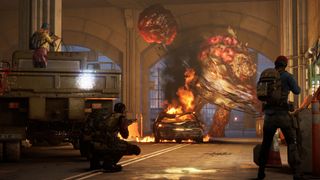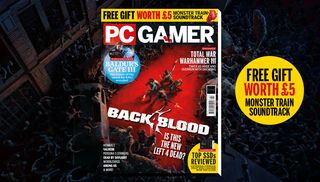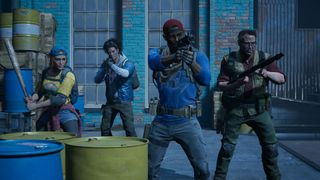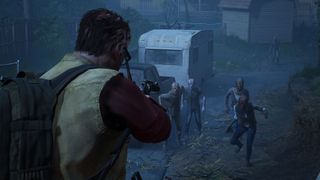Back 4 Blood has bigger ambitions than being Left 4 Dead 3
It's been over a decade since Left 4 Dead 2, and Turtle Rock has some new tricks.


This article first appeared in PC Gamer magazine issue 355 in March 2021. Every month we run exclusive features exploring the world of PC gaming—from behind-the-scenes previews, to incredible community stories, to fascinating interviews, and more.
It's telling of Left 4 Dead's quality that there still isn't a co-op shooter that has quite outdone it. Unlike many popular multiplayer games of 2021, Left 4 Dead doesn't ask you to theorycraft a build or study a meta. There's nothing to understand beyond a few core principles: shoot and keep moving. That purity is why it was a foundational game for my friends and I over a decade ago and why we still squad up to mow down zombies 13 years later.
We've seen plenty of fantastic games riff on Turtle Rock Studios' original template since the series was unceremoniously shelved in 2009, but now its original creators are jumping back into fray. With Back 4 Blood, Turtle Rock is staking its flag in the ground and taking back the genre it created. Well, that's the idea.
New blood
Turtle Rock's first official action as zombie co-op reclaimers? Ditch the survivor narrative. According to Turtle Rock co-founder and design director Chris Ashton, Back 4 Blood's playable characters are hunting the zombies, not the other way around. "Our setting is a year after the apocalypse and answers the question 'What happens next?'. Now we've got stable communities of people in strongholds. We call our hero characters 'Cleaners' because they voluntarily go out into the wild and take on missions to try to put an end to the Ridden," Ashton says. "In our world, there is hope for a future. This theme has a trickle-down effect into all elements of the game."
You feel the tonal difference as Back 4 Blood's characters quip in a more lighthearted, confident way, but the basics really do feel like Left 4 Dead 3. Campaigns follow the same exact four-act structure. Each mission is a familiar mad dash from one safe room to the next. Special infected include a Spitter that can root you in place, a Tallboy with an oversized right hook, and a bloated Retch that will expunge gallons of horde-attracting acid when its belly is pierced. Yep, there's also an AI director pulling the difficulty strings behind the scenes. Treading this well- known ground is a comfortable proposition, but its familiarity is cut by key additions that make Back 4 Blood an inherently deeper and more complicated game.
With one foot firmly in the past and the other dabbling with modern conventions like sprinting, aiming down sights, and character-specific abilities, it's clear that Turtle Rock is after something bigger than a spiritual sequel.
That was cemented when I fired up Back 4 Blood's first mission and discovered how brutal it can be. Weapons and items have to be purchased from safe rooms using in-game copper. Between weapons, attachments, throwables and all-important healing items, my group's shopping list felt as crucial to survival as shooting straight.

Tough crowds
Speaking to teamwork, Ashton says Back 4 Blood's less forgiving elements come down to giving players more ways to succeed (and fail). "The simplest way to drive teamwork is to design a game where it's hard to win otherwise. Players really want to win. So if that means sharing ammo or first aid kits, that's what people are going to do. A less obvious but related philosophy is that we have to leave room for teams to be bad. The more room there is for a team to fail, the more room there is for a team to be extra awesome," he says. "It's important to give teams the space to stand above the rest."
The biggest gaming news, reviews and hardware deals
Keep up to date with the most important stories and the best deals, as picked by the PC Gamer team.
Like several aspects of Back 4 Blood, I'm skeptical of what this economic shift truly adds to the game. Turtle Rock is trying to encourage tactical decisions at the start of a round, but to me it feels limiting at the moment.
Through several playthroughs I saw few opportunities to loot support items off the beaten path. With no promise of another medkit along the way, I noticed a reluctance in my squad to let loose even on the base difficulty. When you do use up resources, it's easy to find yourself on the backfoot heading into the next chapter. Ammo is a big factor in that too. Gone are L4D's universal ammo piles in favour of limited ammo drops divided by weapon type. The last thing I want to do while a horde of 40 zombies chase us down is litigate who needs rifle ammo the most.

Deck slayer
An early winner in Back 4 Blood's new formula is its modifier cards. Every round kicks off with the AI director serving two to four cards that determine which special infected will populate the map. Players react by drafting their own handful of cards from a custom deck. Most cards I was served were passive buffs to healing speed or weak spot damage that can be stacked with your party if they play the same ones. The alpha build had a set number of cards unlocked from the start, but players will find new cards in missions through normal play.
"The goal with this system is to make sure that progression doesn't separate players or do anything funky with the numbers, like zombie health or weapon damage. The idea is that my progression helps you and vice versa," Ashton noted. "The cards also let players customise gameplay to their liking. For example, some nostalgic players don't like aiming "The goal with this system is to make sure that progression doesn't separate players or do anything funky with the numbers, like zombie health or weapon damage. The idea is that my progression helps you and vice versa," Ashton noted. "The cards also let players customise gameplay to their liking. For example, some nostalgic players don't like aiming down sights and prefer to shoot from the hip. There is a card that turns off ADS while greatly increasing hip-fire accuracy on every weapon!"
That last one certainly appeals to me. I appreciate the extra mobility afforded from Back 4 Blood's modern sprint and mantling, but all ADS does is kill the momentum in a game that's all about staying on the move. Another favourite of mine is guaranteed one-hit-kills from my melee attacks, which basically let me run around like a madman knifing zombies in the brain en masse. As far as I'm concerned, they should get even weirder – like Halo skulls weird. Give me a limitless chainsaw that replaces both weapon slots or an obscene speed boost that makes the nasty special infected target me more often. If Turtle Rock is staking Back 4 Blood's replayability on its inventive modifiers, then I hope to see many more cards that meaningfully transform my playstyle.

Co-op shooter
Especially because, wow, it's a good time to shoot stuff with friends cooperatively. There may not be much out there scratching that specific Left 4 Dead itch, there are plenty of incredible co-op shooters that are worth your time. Space dwarf exterminator sim Deep Rock Galactic is only getting better with age as Ghost Ship Games continues to add new biomes and weapons. Fatshark's Vermintide series is a fantastic twist on L4D with a melee focus in a Warhammer-flavoured world. And on the horizon is Rainbow Six Quarantine, a Siege spinoff that is focused entirely on co-op alien zombie murder.
Back 4 Blood certainly has more competition from day one than its predecessors, but that's not worrying Ashton one bit. "We love playing these kinds of games and although there are a good number of competitors out there, we feel there is enough space in the genre for us to do our own thing with Back 4 Blood," he says. Ashton also says that Back 4 Blood isn't taking much direct influence from similar games, but noted that they can inform how their ideas will be received by players. "By-and-large, we really like to keep our heads down and do our own thing, regardless of what the rest of the industry is doing. We're all huge gamers so the hope is always that if we make something we love to play, other gamers will love it too."
One element that basically every modern multiplayer game shares is some sort of ongoing service game model, be it a seasonal battle pass or planned expansions. That's one area that Turtle Rock isn't ready to talk about yet, but Ashton reaffirmed that the team "wants to have ongoing content after launch and are still in the planning phase". Considering the game's structure, it'd certainly make sense to introduce new cards, Cleaners, or weapons on a regular basis. That said, Ashton stopped short of labelling Back 4 Blood a 'service game', so Turtle Rock and its publisher Warner Bros may have different plans...
Assuming a few notable issues like performance dips and strange AI behaviour can be ironed out before launch, Back 4 Blood has a good chance of catching on. It's certainly not the purist Left 4 Dead successor that a part of me still desperately craves, but it's pretty darn close. If you missed the open alpha last year and want to give it a shot before its June 22 release, Turtle Rock is still taking sign-ups for online tests at back4blood.com.

Morgan has been writing for PC Gamer since 2018, first as a freelancer and currently as a staff writer. He has also appeared on Polygon, Kotaku, Fanbyte, and PCGamesN. Before freelancing, he spent most of high school and all of college writing at small gaming sites that didn't pay him. He's very happy to have a real job now. Morgan is a beat writer following the latest and greatest shooters and the communities that play them. He also writes general news, reviews, features, the occasional guide, and bad jokes in Slack. Twist his arm, and he'll even write about a boring strategy game. Please don't, though.
Most Popular

